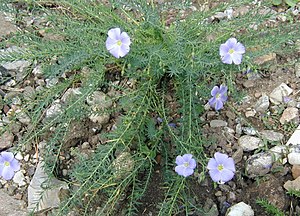Persistent flax
| Persistent flax | ||||||||||||
|---|---|---|---|---|---|---|---|---|---|---|---|---|

Perennial flax ( Linum perenne ) |
||||||||||||
| Systematics | ||||||||||||
|
||||||||||||
| Scientific name | ||||||||||||
| Linum perenne | ||||||||||||
| L. |
The perennial flax , also perennial flax ( Linum perenne ) is a very rare plant species from the genus flax ( Linum ) in Central Europe .
description
The perennial flax is a perennial , herbaceous plant . It reaches heights of growth of (20) 30 to 60 (100) centimeters. The stem has an arched base, otherwise it is upright. The middle stem leaves are one to 2.5 millimeters wide and one to three-veined. The leaf margin is rough due to small teeth.
The inflorescence usually has more than ten flowers. The inner sepals are 3.5 to five millimeters long and are blunt with a tiny spike tip. They protrude beyond the outer sepals by (0.1) 0.3 to 0.6 (1.1) millimeters. The inner ones have a wide skin border and are generally wider than the outer ones. The light blue petals are 15 to 20 millimeters long and nine to twelve millimeters wide. The stamens are around 4.5 millimeters long, glabrous and mostly blue. The stylus are around six millimeters long. Flowering time is June and July, the species occasionally also blooms in October. Pollination occurs through insects or self-pollination .
The fruit stalks are upright when ripe. The capsule is six to seven millimeters long and ovoid-spherical in shape. The seeds are ovate, four millimeters long and brown in color.
The number of chromosomes is 2n = 18.
Spread and endangerment
The perennial flax is native to Europe and western Asia. In Germany it is extremely rare and threatened with extinction, the largest occurrence of the species in Germany is near Darmstadt . It is on level 1 of the Red List of Endangered Species and is strictly protected according to the BArtSchV . In Austria it is also threatened with extinction and only occurs in Lower Austria ( Nibelungengau , perhaps still Wachau ), in Upper Austria it is already extinct. The species is not native to Switzerland. The species is not endangered anywhere in Europe.
The locations are dry grassland and pine forests on dry, humus-rich sand and stone soils, also above loess. The species is restricted to the colline altitude level . He is in Central Europe, a characteristic species of the association Cirsio-Brachypodion.
Systematics
The species Linum perenne used to be broader. The earlier subspecies are now listed as separate species: Linum alpinum and Linum ockendonii . The former subspecies Linum perenne subsp. perenne now forms the species Linum perenne alone .
use
In the past, a coarse, coarse fiber was obtained from the perennial flax , which was used like the linen from the common flax ( Linum usitatissimum ). It is also planted as a garden perennial in heather or rock gardens.
Sources and further information
literature
- Siegmund Seybold (Ed.): Schmeil-Fitschen interactive (CD-Rom), Quelle & Meyer, Wiebelsheim 2001/2002, ISBN 3-494-01327-6
Individual evidence
- ↑ a b Erich Oberdorfer : Plant-sociological excursion flora for Germany and neighboring areas . 8th edition. Verlag Eugen Ulmer, Stuttgart 2001, ISBN 3-8001-3131-5 . Page 631.
- ^ Manfred A. Fischer , Wolfgang Adler, Karl Oswald: Excursion flora for Austria, Liechtenstein and South Tyrol. 2nd, improved and enlarged edition. State of Upper Austria, Biology Center of the Upper Austrian State Museums, Linz 2005, ISBN 3-85474-140-5 .
- ↑ FloraWeb, see web links
- ↑ FloraWeb and Fischer, 2005.

